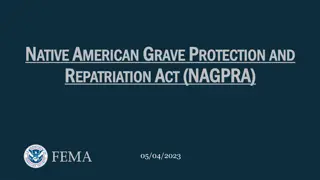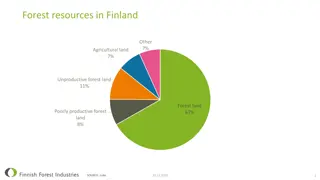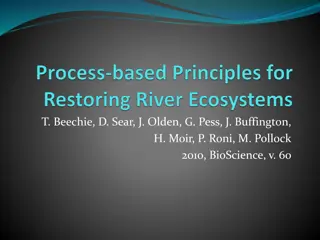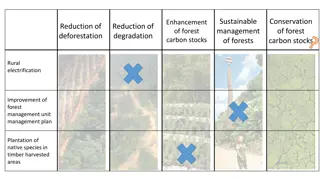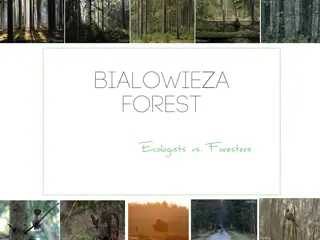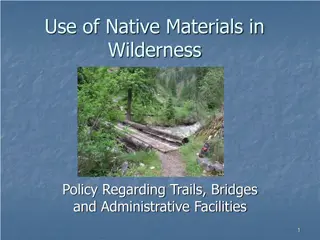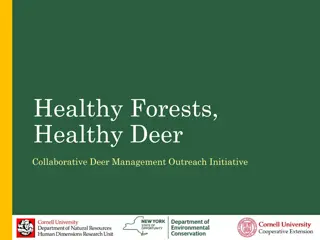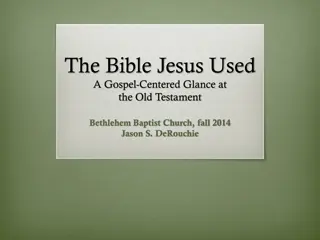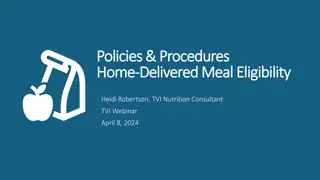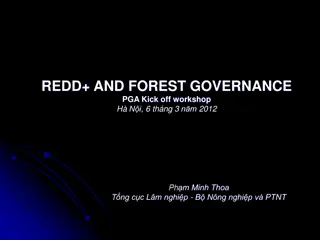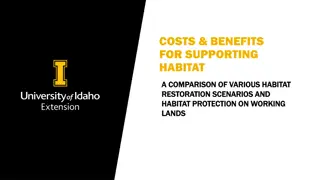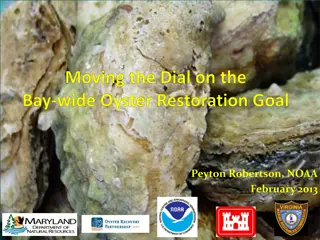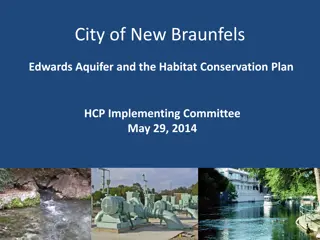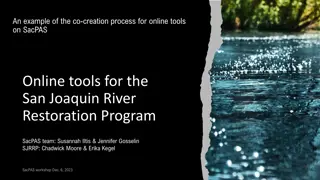Funding for Native Forest Restoration: Tools and Eligibility Criteria
Mapping tools and calculators are essential for identifying funding eligibility for reforestation projects, particularly in areas like erosion-prone land. The integration of Māori-owned land data with emissions trading scheme criteria allows for targeted restoration efforts. By participating in the Emissions Trading Scheme, landowners can earn credits for carbon sequestration and contribute to mitigating climate change.
- Forest Restoration
- Funding Eligibility
- Emissions Trading Scheme
- Māori-owned Land
- Carbon Sequestration
Download Presentation

Please find below an Image/Link to download the presentation.
The content on the website is provided AS IS for your information and personal use only. It may not be sold, licensed, or shared on other websites without obtaining consent from the author. Download presentation by click this link. If you encounter any issues during the download, it is possible that the publisher has removed the file from their server.
E N D
Presentation Transcript
Funding for native forest restoration: Mapping tool and calculator Sam Liberman, Macalester College, Minnesota Suzi Kerr, Motu Sophie Hale, Motu Ano te rite ki te ngahere, Ruatoria, November 2018
Funding Eligibility for Reforestation Emissions Trading Scheme (ETS) Land that was not forest in 1990 Average width greater than 30 metres and greater than 1 hectare Erosion Control Funding Programme (ECFP) Very steep erosion-prone land Classified 6e, 7e, or 8e Total area must be greater than 5 hectares No patch smaller than 1 hectare No existing tree cover on land since 1989 ETS Eligible Land
Funding Eligibility for Reforestation ECFP Eligible Land ETS Eligible Land
Data Sources Title: M ori Land Spatial Dataset Published by: Ministry of Justice and Ministry for Primary Industries on behalf of M ori Land Court What is it? Dataset containing information detailing M ori-owned land in NZ Title: Land Use and Cover Survey (LUCAS) Dataset Published by: Ministry for the Environment What is it? Dataset describing land use and land classifications in NZ Various reference data from Land Information New Zealand
Making the Map Intersected Emissions Trading Scheme eligible land layer with M ori-owned land layer What does that mean? Intersected that with 6e, 7e, 8e land layer to create ECFP eligible land layer
Using the Map
Block Title: Section 6 and Section 7 Block XII Mangaoporo Survey District Management Name: Proprietors of Rotokautuku X1C ECFP and ETS Eligible Land: 335.58 ha ETS but not ECFP Eligible: 72.34 ha Land ineligible for funding: 85.03 ha
The Emissions Trading Scheme register and claim credits If your land is eligible you can choose to participate A broker can help you with the process of registration Once your land has forest you can receive credits each year (or every 5 years) because your trees sequester carbon out of the atmosphere and reduce climate change A forest has 30% canopy cover and species that can reach 5 metres A broker can help you claim the credits (from 2018)
Selling credits Option 1 Once you have credits you can sell them through a broker Option 2 You could sign an agreement in advance with a buyer You could receive cash upfront to help establish the forest You could get a guaranteed price for a few years If you do sell your credits and later decide to clear your forest you need to buy credits back.
Large emitters are keen to engage When I think about the deals we have done, they have largely been because we care about the relationship. So I think you do need to have people who within the organisations that want a relationship and that are prepared to invest some time and energy in getting transactions completed.
Some are willing to do small deals To be honest I think today if someone came to me and said, I've got 5000 credits, would you be interested? We would say yes And I think that is the right thing to do because in this space you almost need to pilot and test things and help everyone grow their confidence in the system.
But all would prefer blocks of land to be aggregated There is opportunities for someone being able to act as more of an aggregator, because would it be easier for us to do three big deals rather than 100 small ones? Definitely. There is compliance costs in there and the administration that goes with signing up different contracts.
Brokers play an important role [The broker] basically did everything he was the counterparty s agent. I wouldn't want to cut a long-term deal with [landowners] if they didn't have sufficient advice, so having [the broker] there made things quicker and it meant that we both knew that he knew what he was talking about.
There are multiple options for contracts We would be there for either providing capital for that or providing certainty of offtake. That is something that we could do, would be doing an investment up front and get paid back our investment through carbon credits. Because the other alternative [than buying credits] is that you have a capital intensive one whereby we would make a direct investment. So we would pay for the conversion to native forestry so we would rather than just being a buyer we are actually an investor.
So how much could you get for native forest? Calculator provide indicative value based on your assumptions Example 1: Bare pasture ETS and ECFP eligible
Example 2: 10-year old forest - ETS eligible Doesn t get ECFP grant but gets more ETS credit
The block that Sam showed 335.58 ha eligible for ECFP and ETS 72.34 ha eligible only for ETS







